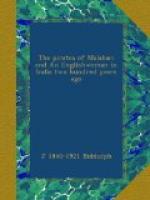The amnesty granted to some pirates, the hanging of others,[5] and the new Act of Parliament, caused a great abatement of the evil. The Madagascar settlements still flourished, but for a time European trade was free from attack. Littleton’s squadron had gone home, and was replaced by two royal ships, the Severn and the Scarborough, which effected nothing against the pirates, but served by their presence to keep them quiet.
The Severn and Scarborough sailed from England in May, 1703, under Commodore Richards, who died at Johanna in the following March. The command was then taken by Captain Harland, who visited Madagascar and Mauritius, where two men were arrested, who afterwards made their escape at Mohilla. The two ships returned to England in October, 1705.
Hamilton tells us how a
“Scots ship commanded by one Millar did the public more service in destroying them, than all the chargeable squadrons that have been sent in quest of them; for, with a cargo of strong ale and brandy, which he carried to sell them, in anno 1704, he killed above 500 of them by carousing, although they took his ship and cargo as a present from him, and his men entered, most of them into the society of the pirates.”
[1] This was probably a village near Ras Mabber, about
one hundred and
sixty-five miles south of
Cape Guardafui.
[2] In ships of this class the quartermaster was next
in importance to the
captain or master. The
incident refers to the death of Moore, the
gunner of the Adventure,
who was killed by Kidd in a fit of anger
for saying that Kidd had ruined
them all. The killing of Moore was one
of the indictments against
Kidd at his trial.
[3] Warren had returned from his first cruise in the autumn of 1697.
[4] One small Arab vessel that rashly attacked the
Harwich, mistaking it
for a merchant vessel, was
disposed of with a broadside.
[5] Twenty were condemned and hung in one batch, in
June, 1700; one of the
Mocha mutineers among
them. This was probably Guillam, to whom Kidd
had given a passage to America
from Madagascar, and was supposed to
have been the man who stabbed
Captain Edgecombe.




